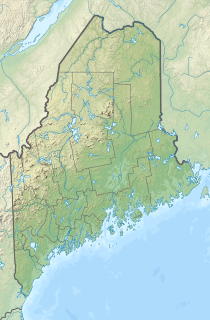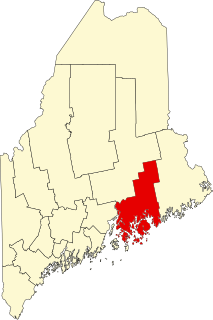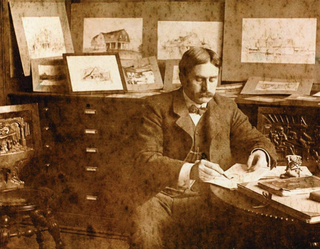
Acadia National Park is an American national park located along the mid-section of the Maine coast, southwest of Bar Harbor. The park preserves about half of Mount Desert Island, part of the Isle au Haut, the tip of the Schoodic Peninsula, and portions of 16 smaller outlying islands. It protects the natural beauty of the rocky headlands, including the highest mountains along the Atlantic coast. Acadia boasts a glaciated coastal and island landscape, an abundance of habitats, a high level of biodiversity, clean air and water, and a rich cultural heritage.

Bar Harbor is a town on Mount Desert Island in Hancock County, Maine, United States. As of the 2010 census, its population is 5,235. During the summer and fall seasons, it is a popular tourist destination and, until a catastrophic fire in 1947, the town was a noted summer colony for the wealthy.

Mount Desert Island in Hancock County, Maine, is the largest island off the coast of Maine. With an area of 108 square miles (280 km2) it is the 52nd-largest island in the United States, the sixth-largest island in the contiguous United States, and the second-largest island on the Eastern Seaboard, behind Long Island and ahead of Martha's Vineyard. According to the 2010 census, the island has a year-round population of 10,615. In 2017, an estimated 3.5 million tourists visited Acadia National Park on MDI. The island is home to numerous well-known summer colonies such as Northeast Harbor and Bar Harbor.

Saint Croix Island, long known to locals as Dochet Island, is a small uninhabited island in Maine near the mouth of the Saint Croix River that forms part of the Canada–United States border separating Maine from New Brunswick. The island is in the heart of the traditional lands of the Passamaquoddy people who, according to oral tradition, used it to store food away from the dangers of mainland animals. The island was the site of an early attempt at French colonization by Pierre Dugua, Sieur de Mons in 1604. In 1984 it was designated by the United States Congress as Saint Croix Island International Historic Site. There is no public access to the island, but there is a visitor contact station on the U.S. mainland and a display on the Canadian mainland opposite the island.

Robert Abbe was an American surgeon and pioneer radiologist in New York City. He was born in New York City and educated at the College of the City of New York and Columbia University.

Port-Royal National Historic Site is a National Historic Site located on the north bank of the Annapolis Basin in the community of Port Royal, Nova Scotia, Canada. The site is the location of the Habitation at Port-Royal.

Bass Harbor Head Light is a lighthouse located within Acadia National Park in the southwest portion of Mount Desert Island, Maine, marking the entrance to Bass Harbor and Blue Hill Bay.

This is a list of the National Register of Historic Places listings in Hancock County, Maine.

Somesville is the earliest village of the town of Mount Desert on Mount Desert Island in southeastern Maine. It is located on the north end of Somes Sound. The village was established by Abraham Somes who was the first settler on the island. It attracted many people because of its mills and quarries. The entire village is part of the Somesville Historic District.

Bear Island Light is a lighthouse on Bear Island near Mt. Desert Island, at the entrance to Northeast Harbor, Maine. It was first established in 1839. The present structure was built in 1889. It was deactivated in 1981 and relit as a private aid to navigation by the Friends of Acadia National Park in 1989. Bear Island Light was listed on the National Register of Historic Places as Bear Island Light Station on March 14, 1988.

Baker Island Light is a lighthouse on Baker Island, Maine, which is part of Acadia National Park. The light station was established in 1828 as a guide to the southern entrance to Frenchman Bay. The present tower was built in 1855; the well-preserved tower, keeper's house, and associated outbuildings were listed on the National Register of Historic Places in 1988.
The Harbor Lane–Eden Street Historic District encompasses a neighborhood of Bar Harbor, Maine, consisting of architect-designed summer estates that served as the summer of elite society families of the late 19th and early 20th centuries. Located northwest of the main village and fronting on Frenchman Bay, the district includes nine summer houses that survived a devastating 1947 fire which destroyed many other summer estates. The district was listed on the National Register of Historic Places in 2009.

Fort William Henry is located in the village of New Harbor in the town of Bristol, Maine. The fort was, in its time, the largest in New England. The fort was originally built in 1692 but destroyed four years later by New France in the Siege of Pemaquid (1696). A reconstruction was built in 1908. The fort was added to the National Register of Historic Places on December 1, 1969. Fort William Henry is now operated as a museum about the fort's history.
This is a list of the National Register of Historic Places listings in Acadia National Park.

Blackwoods Campground is located on the east side of Mount Desert Island, off Maine State Route 3 in Acadia National Park. Construction on the site was begun by the Civilian Conservation Corps (CCC) in 1935, and reaching its present appearance around 1961, with the completion of Loop B. The campground has 306 individual campsites, several group campsites, and offers only limited amenities, which include potable water and restrooms, but not showers or electrical hookups. Campsites may be reserved up to six months in advance. The portion of the campground built by the CCC, which includes its core and Loop A, was listed on the National Register of Historic Places in 2007.

The Fernald Point Prehistoric Site is an archaeological site in Acadia National Park on Mount Desert Island on the central coast of Maine. The principal feature of the site is a shell midden, whose excavation has yielded both historic artifacts and evidence of human occupation to at least 1000 BCE. The site was listed on the National Register of Historic Places in 1978.

Seawall Campground is a campground in Acadia National Park on Mount Desert Island off the coast of Maine. The campground offers four loops of campsites, including "drive-up" sites suitable for RVs and trailers, as well as walk-in tent-only campsites, and is open from late May into October. Much of the campground was built between 1936 and 1942 by crews of the Civilian Conservation Corps; this section is listed on the National Register of Historic Places. The campground is located in the village of Seawall, in the town of Southwest Harbor on Maine State Route 102A.

The Musée Culturel du Mont-Carmel is a museum of local history on United States Route 1 in Grand Isle, Maine. It is located in the former Our Lady of Mount Carmel Catholic Church, one of the only surviving 19th-century Acadian churches in northern Maine. The architecturally distinctive building was listed on the National Register of Historic Places in 1973.

George Bucknam Dorr was an American preservationist. Known as the "father of Acadia National Park," he spent most of his adult life overseeing the park's formation and expansion.

Frederick Lincoln Savage was an American architect, known as Mount Desert Island's most prolific native architect. During the late 19th and early 20th centuries, he designed over 300 cottages on the island and across Northeastern Maine, including Reverie Cove and the John Innes Kane Cottage in Bar Harbor, and Raventhorp in Southwest Harbor, all listed on the National Register of Historic Places (NRHP). He also designed the NRHP-listed West Gouldsboro Village Library in Gouldsboro, Maine.



















